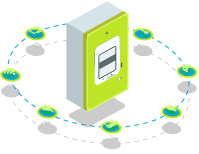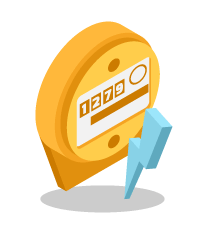Electricity Meters in France: types, usage and readings

Whether you live in France or have a second home in the country, if your home is heated with electricity you will have a meter.
What is the use of an electricity meter?
An electricity meter is a device located upstream of an indoor electric system and is used to measure energy consumption.
Thanks to a meter, it is possible to know exactly how many kWh a household is consuming. Note that a meter is never reset, even if the home owner changes. You thus need to subtract the index displayed on the meter from the digit on your previous electricity bill.
The different types of electricity meters
There are 3 types of electricity meters in France: the electromechanical meter, which was invented at the end of the 19th century, the electronic meter which appeared in the second half of the 20th century and Linky, the new "smart" meter that has recently begun to replace its predecessors nationwide.
Electromechanical meters

The electromechanical meter is the oldest type of meter in France, and was the most popular until the Linky model made its appearance. It works thanks to a metallic disk which rotates with a speed proportionate to the household's electricity conmsuption. Thus, the faster a meter turns, the higher the consumption is, with each disk turn corresponds to a certain amount of consumed kWh.
Unlike newer meter readings, it doesn't allow you to get precise information on your actual daily consumption.
If you are subscribed to a "Base" option, the meter has just one screen, whereas it will have 2 screens if you are subscribed to a "Heures Pleines / Heures Creuses" or "Tempo" option.
Electromechanical meters are from now on replaced with new and "smart" meters once they start malfunctioning or during a new connection to the electricity network.
Electronic meters

The electronic meter are a more evolved version of the electromechanical one. Its most popular model is known as the "Sagem EDF". Electronic meters have a screen and 2 buttons "S" and "D" These are the only 2 buttons you should use, the rest under the screen is only to be manipulated by techinicians.
The D button enables you to access your meter index. If you are subscribed to the "Base" option, you will have just one index to look out for. However, if you have the "Heures Pleines / Heures Creuses option, you will need to take note of the index for both peak and off-peak hours.
As for the S buttons, it switches the display on the screen from one information to another, in this order:
- the power of the meter or "puissance de compteur"
- the tariff option subscribed to
- the selected setting for the circuit breaker
- the subscribed power (between 3 kVA to 36 kVA for private customers)
- the instantaneous intensity activated (in watts) and the apparent power (in volt-ampere)
- the maximum intensity reached
- the serial number
- the status of the output contacts
- the instantaneous consumption meter, which gives you the amount of kW consumed during a given period. You can reset this counter to 0 when you want via the D button
- the control of the screen functioning.
Like electromechanical models, electronic meters are from now on replaced with smart meters once they start malfunctioning or during a new connection to the electricity network.
Smart meters

Also known as Linky meters, smart meters have revolutionised the electricity sector, as they give access to more information that ever before.
The goal behind these smart meters is to enhance energy efficiency in France and Europe. Indeed, with smart meters, consumption can be communicated directly to a provider and the device can be auto-set without a technician having to come round.
By 2022, 35 million French households will have been equipped with a Linky device. Note that any new connection to the electricity network that is set up today will automatically be with a Linky meter.
The Linky meter has 2 buttons, "+" and "-" to make the different pieces of information scroll down.
How to locate an electricity meter
Just moved into your new home in France and unsure where your electricity meter is? Don't worry, it shouldn't be too difficult to locate, you just need to know where to look. Note that it can be either inside or outside. Below are a few tips to help you find your meter in no time
Try looking in the following places:
- Outside your home:
- In a cupboard on the landing
- In a basement or a machine room on the ground floor of your apartment building
- Inside your home:
- In a cupboard
- In your garage
- In your house basement
- In your house entrance
Do you live in a building and aren't know which meter is yours? It's easy. Electricity bills indicate a meter number, and each meter is identified by unique number (engraved on the device). If there are several meters in your apartment complex, use this registration number to identify with certainty the correct counter.
How to do a meter reading in France
Meter readings are planned at least once every 6 months, with the next one scheduled often written on your latest electricity bills. In some cases, you may have to do your own meter readings, so it is thus very useful to know ahead of time how to read meters.
In which cases should I do my own reading?
You have to proceed to a meter reading in the following scenarios:
- when moving to a new house and starting a new electricity account in France
- if you ever missed a semestrial appointment with the ENEDIS technician
- if you wish to change energy suppliers
- if you want to start self-reporting electricity consumption, in order to get billed your actual consumption (and not an estimate)
How to proceed
Meter reading methods may differ depending on the type of device you own.
For an electromechanical meter
Usually black or blue, electromechanical meters have one or two dials and a wheel. If the device has 2 dials, this means that the meter is set to the peak / off-peak hours (heures pleines / heures creuses) option. To read the meter, just take note of the numbers written on the dial(s). If you are subscribed to the peak / off-peak option, you should distinguish the "HP" (Heures Pleines) dial from the "HC" (Heures Creuses) dial when taking note of the readings.
For an electronic meter

More recent homes are equipped with these electronic meters. Often grey or white, they will have you will see a little "HC" and "HP" displayed on the screen if the meter is programmed in peak / off-peak hours.
Press on the "D" button, until the index of consumption appears, either as a single set of numbers or as 2 sets.
You will then simply take note of the single number on screen if you are subscribed to the "Base" option, or of the 2 numbers that appear if you have the heures pleines / heures creuses option.
For a smart meter

With smart meters, no need to take note of your consumption index - data is automatically transferred onto your energy provider via the ENEDIS network. So no need for reportings or for a technician to come to your home anymore.
If you want to check your consumption, simply press the scroll button as with the electronic meter.
Meter readings done by a technician (ENEDIS)
Meter reading by ENEDIS are done free of charge, every 6 months.
What happens during a technical intervention
You are always informed in advance of the date of the next meter reading. You will always receive a letter informing you of the date and time slot of the technician's intervention ahead of time. In addition, the approximate date of the next scheduled reading is shown on the electricity bill, under the amount to be paid. Finally, ENEDIS has set up an SMS and email alert service to remind you of the technician's intervention.
During the intervention, the technician takes note of the actual index, which is the difference between the latest meter reading and the reading observed during the intervention. This data is then passed on to the electricity supplier so that it can bill the customer's actual consumption.
What if I’m away during a planned meter reading?
If you miss a technician's intervention, don't worry - it is always possible to transfer you meter reading to ENEDIS over the phone, online or via a pre-stamped letter that you leave in your letterbox.
 |
|
|---|---|
| Over the phone | 0 820 333 433 (€0,118 with tax per minute) |
| Online | ENEDIS Customer account |
If you don't communicate your reading within 10 days, the network manager will proceed to an estimation of your consumption. This said, it is still compulsory for a technician to come to your home in order to set up your regulating bill. If this still isn't possible, your provider will ask for a special paid appointment, via the network manager.
If you are away during a planned meter reading by a technician, note that you can be represented by someone else who will be able to let the technician in. Some professionals also accept to take readings from a sticky note left on a front door of the occupant's house or apartment.
Meters and changes to a situation
Here is how to proceed if your current energy situation changes, and how it may impact your meter.
What happens to a meter when changing providers?

Nothing! If you decide to switch your energy supplier in France, for instance if you had an EDF meter and want to swtich to getting electricity from another provider, your electrical installation stays the same, and no technician will come to your home to touch your meter. This also means you won't have to undergo power cut, and no costs will be incurred. ENEDIS remains in charge of the maintenance of all meters in France, regardless of your supplier.
What happens to a meter when moving home?
If you ever move house or apartment in France or move abroad, here is how to proceed with your meter and electricity contract.
Before leaving your home
The day of your move, you have to contact your energy supplier to terminate your contract. You will also have to send them the current index indicated on the housing meter. This end of period index will allow your provider to send you your last closing bill, according to your exact consumption. This action will terminate your electricity contract for that home. However, be sure to remember to sign a new contract for your next home.
For more information about electricity suppliers and finding the offer right for you, call our English-speaking advisors at 09 87 67 37 93 or get a free callback (Monday to Friday 8am-8.30pm and Saturday 9am-6pm).
Once you are in your new home
Ideally, a few days before moving in, you should contact your chosen electricity supplier to take out a contract and get electricity set up. You can open a meter with EDF or with any other supplier on the market; the steps are identical. In addition to your exact address, the new provider will ask you to take the index on the meter of the new home, which will serve as an index of beginning of period to then establish your invoices. Do not hesitate to ask the former owner or your agency to obtain this index.
Sometimes, electricity is cut off when new tenants arrive, and the quick intervention of a technician to deliver electricity is very expensive. The best way to avoid this kind of inconvenience is to take out an electricity contract as soon as possible.
Can a meter be replaced or changed location?

Under some circumstances, yes. The conditions and rules for changing and moving the electricity meter are not the same, so it is therefore important to identify your needs and the case that best suits your situation.
In the case of a faulty or old generation replacement, you can change your electricity meter for free. You are responsible to pay for the replacement if it is linked to a change of tariff option, the modification of your subscribed power or a three-phase installation.
Moving the meter is possible or essential, for example in the case of renovation works in your home. But in this case, the costs will be entirely your responsibility.
 alt="energy in france" />
alt="energy in france" />
